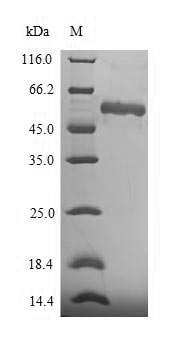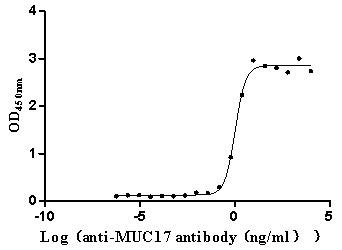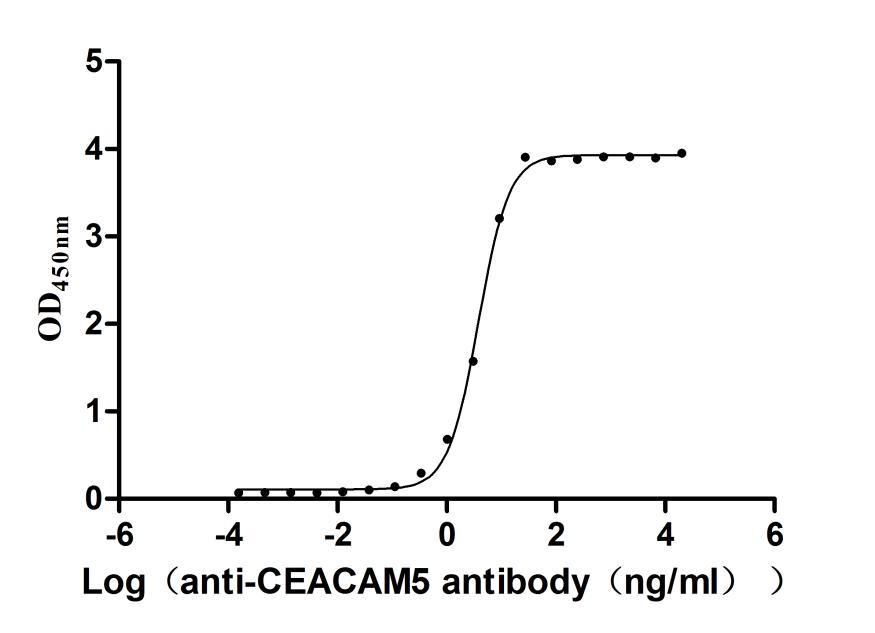Recombinant Human Asporin (ASPN)
In Stock-
中文名称:Recombinant Human Asporin(ASPN)
-
货号:CSB-EP002230HU
-
规格:¥1836
-
图片:
-
其他:
产品详情
-
纯度:Greater than 90% as determined by SDS-PAGE.
-
基因名:ASPN
-
Uniprot No.:
-
别名:ASPN; ASPN protein; ASPN_HUMAN; Asporin (LRR class 1); Asporin; Asporin proteoglycan; FLJ20129; LRR class 1; Periodontal ligament associated protein 1; Periodontal ligament-associated protein 1; PLAP 1; PLAP-1; PLAP1; SLRR 1C; SLRR1C; Small leucine rich protein 1C
-
种属:Homo sapiens (Human)
-
蛋白长度:Full Length of Mature Protein
-
来源:E.coli
-
分子量:55.7kDa
-
表达区域:33-380aa
-
氨基酸序列DMEDTDDDDDDDDDDDDDDEDNSLFPTREPRSHFFPFDLFPMCPFGCQCYSRVVHCSDLGLTSVPTNIPFDTRMLDLQNNKIKEIKENDFKGLTSLYGLILNNNKLTKIHPKAFLTTKKLRRLYLSHNQLSEIPLNLPKSLAELRIHENKVKKIQKDTFKGMNALHVLEMSANPLDNNGIEPGAFEGVTVFHIRIAEAKLTSVPKGLPPTLLELHLDYNKISTVELEDFKRYKELQRLGLGNNKITDIENGSLANIPRVREIHLENNKLKKIPSGLPELKYLQIIFLHSNSIARVGVNDFCPTVPKMKKSLYSAISLFNNPVKYWEMQPATFRCVLSRMSVQLGNFGM
Note: The complete sequence including tag sequence, target protein sequence and linker sequence could be provided upon request. -
蛋白标签:N-terminal 6xHis-SUMO-tagged
-
产品提供形式:Liquid or Lyophilized powder
Note: We will preferentially ship the format that we have in stock, however, if you have any special requirement for the format, please remark your requirement when placing the order, we will prepare according to your demand. -
缓冲液:Tris-based buffer,50% glycerol
-
储存条件:Store at -20°C/-80°C upon receipt, aliquoting is necessary for mutiple use. Avoid repeated freeze-thaw cycles.
-
保质期:The shelf life is related to many factors, storage state, buffer ingredients, storage temperature and the stability of the protein itself.
Generally, the shelf life of liquid form is 6 months at -20°C/-80°C. The shelf life of lyophilized form is 12 months at -20°C/-80°C. -
货期:3-7 business days
-
注意事项:Repeated freezing and thawing is not recommended. Store working aliquots at 4°C for up to one week.
-
产品描述:
The expression of recombinant human ASPN protein includes the construction of the expression vector containing the recombinant DNA and the transformation of the expression vector into the E.coli, which provides a variety of macromolecules and components required for transcription and translation. The recombinant DNA was formed by fusing the N-terminal 6xHis-SUMO tag sequence to the designated sequence encoding the 33-380aa of the human ASPN protein. This N-terminal 6xHis-SUMO-tagged recombinant human ASPN protein is also characterized by high purity, >90%. Under SDS-PAGE condition, this recombinant ASPN protein migrated to the band of about 55 kDa molecular weight.
It is well-documented that ASPN was upregulated in different stages of gastric cancer (GC),and associated with a poor prognosis and could serve as a potential prognostic biomarker in colorectal cancer. Further data suggested that it promotes the migration and invasion of colorectal cancer cells via TGFβ/Smad2/3 pathway. Asporin as an ECM protein, which belongs to a small leucine-rich proteoglycan family. In ovarian cancinoma, researchers determined that ASPN is highly expressed in CAFs of high grade serous ovarian cancinoma patients and predicts poor prognosis. Moreover, ASPN may be a potential promising biomarker for heart failure. ASPN protein was reported to significantly increased in ischemic cardiomyopathy and dilated cardiomyopathy left ventricular samples. ASPN protein was significantly increased in ICM and DCM left ventricular samples. In additon, asporin levels will be increased as a result of degeneration in advanced TMJ joint disease with tissue damage.
-
Datasheet & COA:Please contact us to get it.
相关产品
靶点详情
-
功能:Negatively regulates periodontal ligament (PDL) differentiation and mineralization to ensure that the PDL is not ossified and to maintain homeostasis of the tooth-supporting system. Inhibits BMP2-induced cytodifferentiation of PDL cells by preventing its binding to BMPR1B/BMP type-1B receptor, resulting in inhibition of BMP-dependent activation of SMAD proteins. Critical regulator of TGF-beta in articular cartilage and plays an essential role in cartilage homeostasis and osteoarthritis (OA) pathogenesis. Negatively regulates chondrogenesis in the articular cartilage by blocking the TGF-beta/receptor interaction on the cell surface and inhibiting the canonical TGF-beta/Smad signal. Binds calcium and plays a role in osteoblast-driven collagen biomineralization activity.
-
基因功能参考文献:
- D-repeat of ASPN gene is mainly associated with male patients. The D13 polymorphism plays a protective role for osteoarthritis in Caucasians male individuals while D14 plays a risk factor for knee osteoarthritis in male patients. PMID: 30407347
- Suggest that the D14 allele of the ASPN polymorphism could exert an influence on primary osteoarthritis of the knee etiology in a Mexican Mestizo population. PMID: 26620055
- ASPN D-repeat polymorphism is not associated with an increased Knee Osteoarthritis risk. PMID: 28889984
- Meta-analysis result based on previously published studies demonstrated that the ASPN D13 allele was a protective factor for OA of knee, hip, and hand. For D14 and D15 allele, meta-analysis did not demonstrate statistically significant association. PMID: 29561445
- higher expression of asporin was noticed in CRC tissues and it was correlated with later clinical stage of the patients. Asporin promoted the migration and invasion of the tumor cells partially through an EGFR/Src/cortactin- signaling pathway. PMID: 27705916
- ASPN D15 is associated with increased risk of symmetrical hand osteoarthritis particularly in individuals with low variation in work tasks. PMID: 29233086
- we found that asporin can be downregulated by bone morphogenetic protein 4 in Hs578T cells and its upregulation may be facilited by serum-free cultivation or by three dimensional growth PMID: 27409832
- Asporin promotes epithelial mesenchymal transformation, invasion, and migration of pancreatic cancer cellss by activating CD44-AKT/ERK-NF-kappaB pathway in paracrine and autocrine manner. PMID: 28400334
- High ASPN expression in stroma is associated with prostate cancer progression. PMID: 28152543
- To test the associations of ASPN variations with risk of subsequent oncologic outcomes. PMID: 26446945
- Collectively, our findings indicate that ASPN is upregulated and plays an oncogenic role in gastric cancer progression and metastasis by influencing the EGFR signaling pathway. PMID: 25673058
- Our results showed that ASPN rs13301537 T to C change and variant C genotype may contribute to knee OA risk in a Chinese Han population. PMID: 25030405
- this is the first case-control study in Mexican women that suggests that menopause and the D-repeat polymorphism in the ASPN gene are associated with knee OA PMID: 26016288
- Osteomodulin, osteoglycin, and asporin appear to be distinctly regulated in osteoarthritis labrum compared to OA cartilage. PMID: 25371314
- Asporin may represent a new therapeutic target molecule for the development of drugs aimed at manipulating the cancer microenvironment. PMID: 24441039
- This meta-analysis shows that the ASPN D14, D13, and D15 alleles are not associated with the development of osteoarthritis in Europeans and Asians. [Meta-Analysis] PMID: 24306268
- A meta-analysis suggest that the D-repeat of asporin gene (ASPN) may not be a major susceptibility locus in the Caucasian and Asian populations with knee osteoarthritis. PMID: 23942062
- polymorphisms within the ASPN gene could influence knee osteoarthritis susceptibility PMID: 23733110
- D14-PLAP-1 suppressed BMP-2 signal transduction more efficiently than D13-PLAP-1; stronger affinity of D14-PLAP-1 protein to BMP-2 compared with D13-PLAP-1 protein. D repeat polymorphism of PLAP-1/asporin has influence on functions of PDL cells. PMID: 24453179
- Our data suggest that the D15 asporin allele could be considered a knee osteoarthritis risk allele significant only for women in the Iranian population. PMID: 24078942
- The asporin-encoding gene is a promising candidate as a susceptibility gene for osteoarthritis and degenerative disc disease. [Review] PMID: 24003854
- Asporin is associated with hand osteoarthritis progression. PMID: 23357225
- mir-101 and mir-21 target PLAP-1 to regulate its expression during osteogenic differentiation of PDLCs. PMID: 22367347
- Our results show an obvious association between the D repeat polymorphism of ASPN and Developmental dysplasia of the hip PMID: 21329514
- Data indicate that the expression of ASPN gene is finely regulated in cartilage and suggest a major role of Sp1. PMID: 21528154
- ASPN plays positive roles in the mineralization of dental pulp stem cells and predentin to dentin. PMID: 21413025
- The ratio of Asporin to TGF-beta1 (transforming growth factor-beta1) mRNA in patients with severe cartilage damage was higher than that in osteoartritis patients with mild cartilage damage PMID: 19997821
- Association of an asporin repeat polymorphism with ankylosing spondylitis in Han Chinese population: a case-control study, is reported. PMID: 20144272
- these findings provide another functional link between extracellular matrix proteins, TGF-beta activity and disease, suggesting new therapeutic strategies for osteoarthritis. PMID: 15640800
- No significant differences were observed in any of the multiple comparisons performed in osteoarthritis and controls PMID: 16542493
- expression may be associated with the process of cytodifferentiation of periodontal ligament cells PMID: 16632759
- Association of the D14 allele with knee osteoarthritis susceptibility in Han Chinese. PMID: 17024313
- the association of the ASPN D14 allele and knee OA has global relevance [meta-analysis] PMID: 17517696
- This study further highlighted the significance of asporin in osteoarthritis. PMID: 17603749
- Characterization of the human ASPN promoter region revealed a region from -126 to -82 that is sufficient for full promoter activity; however, TGF-beta1 failed to increase activity through the ASPN promoter. PMID: 17804408
- describe mechanisms for asporin function and regulation in human articular cartilage; asporin blocks chondrogenesis and inhibits TGF-beta1-induced expression of matrix genes and the resulting chondrocyte phenotypes. PMID: 17827158
- The frequency of the aspartic acid repeat polymorphism was examined. These results suggest that asporin may play a role in OA susceptibility of the knee in the Korean female population. PMID: 18178444
- ASPN is a lumbar-disc degeneration (LDD) gene in Asians, and common risk factors may be considered for osteoarthritis and LDD. PMID: 18304494
- Asporin is up-regulated in disease states. It binds to various growth factors, including TGF-beta and BMP-2, and negatively regulates their activity. By inhibiting binding of TGF-beta1 to its type II receptor, asporin forms a functional feedback loop. PMID: 18336287
- These data suggest that polymorphisms within ASPN are not a major influence in susceptibility to hand or knee OA in US Caucasians. PMID: 18434216
- In the discs of Caucasian subjects there was greatest expression of asporin in the more degenerate human discs in vivo. PMID: 19327154
- Asporin has a role in osteoblast-driven collagen biomineralization activity. PMID: 19589127
显示更多
收起更多
-
相关疾病:Osteoarthritis 3 (OS3); Intervertebral disc disease (IDD)
-
亚细胞定位:Secreted, extracellular space, extracellular matrix.
-
蛋白家族:Small leucine-rich proteoglycan (SLRP) family, SLRP class I subfamily
-
组织特异性:Higher levels in osteoarthritic articular cartilage, aorta, uterus. Moderate expression in small intestine, heart, liver, bladder, ovary, stomach, and in the adrenal, thyroid, and mammary glands. Low expression in trachea, bone marrow, and lung. Colocaliz
-
数据库链接:
HGNC: 14872
OMIM: 603932
KEGG: hsa:54829
STRING: 9606.ENSP00000364694
UniGene: Hs.435655
Most popular with customers
-
Express system: Mammalian cell
Species: Macaca fascicularis (Crab-eating macaque) (Cynomolgus monkey)
-
Recombinant Mouse Claudin-18 (Cldn18)-VLPs (Active)
Express system: Mammalian cell
Species: Mus musculus (Mouse)
-
Recombinant Human Claudin-6 (CLDN6)-VLPs (Active)
Express system: Mammalian cell
Species: Homo sapiens (Human)
-
Recombinant Human Mucin-17 (MUC17), partial (Active)
Express system: Mammalian cell
Species: Homo sapiens (Human)
-
Recombinant Human Carcinoembryonic antigen-related cell adhesion molecule 6 (CEACAM6) (Active)
Express system: Mammalian cell
Species: Homo sapiens (Human)
-
Recombinant Human Serine/threonine-protein kinase receptor R3 (ACVRL1), partial (Active)
Express system: Baculovirus
Species: Homo sapiens (Human)
-
Express system: Mammalian cell
Species: Macaca mulatta (Rhesus macaque)




-AC1.jpg)
-AC1.jpg)














